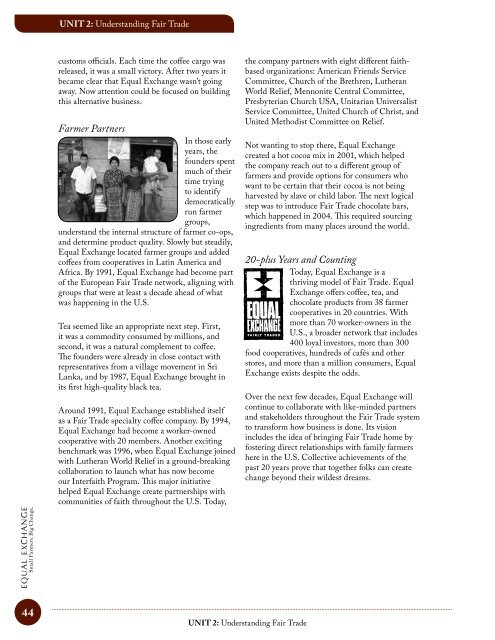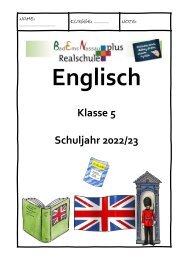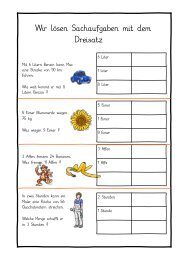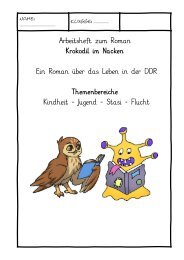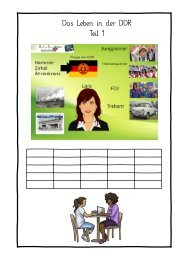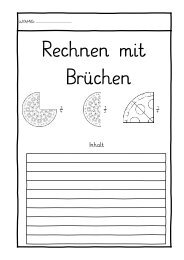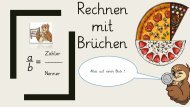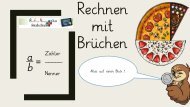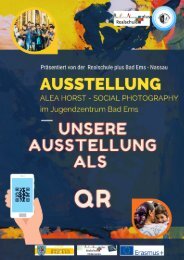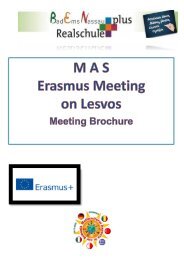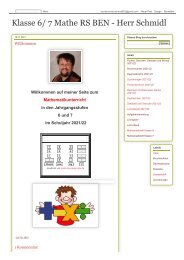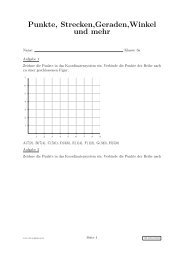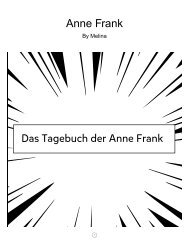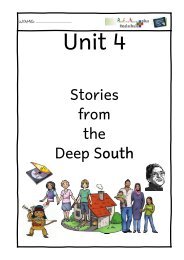You also want an ePaper? Increase the reach of your titles
YUMPU automatically turns print PDFs into web optimized ePapers that Google loves.
UNIT 2: Understanding Fair Trade<br />
customs officials. Each time the coffee cargo was<br />
released, it was a small victory. After two years it<br />
became clear that Equal Exchange wasn’t going<br />
away. Now attention could be focused on building<br />
this alternative business.<br />
Farmer Partners<br />
In those early<br />
years, the<br />
founders spent<br />
much of their<br />
time trying<br />
to identify<br />
democratically<br />
run farmer<br />
groups,<br />
understand the internal structure of farmer co-ops,<br />
and determine product quality. Slowly but steadily,<br />
Equal Exchange located farmer groups and added<br />
coffees from cooperatives in Latin America and<br />
Africa. By 1991, Equal Exchange had become part<br />
of the European Fair Trade network, aligning with<br />
groups that were at least a decade ahead of what<br />
was happening in the U.S.<br />
Tea seemed like an appropriate next step. First,<br />
it was a commodity consumed by millions, and<br />
second, it was a natural complement to coffee.<br />
The founders were already in close contact with<br />
representatives from a village movement in Sri<br />
Lanka, and by 1987, Equal Exchange brought in<br />
its first high-quality black tea.<br />
Around 1991, Equal Exchange established itself<br />
as a Fair Trade specialty coffee company. By 1994,<br />
Equal Exchange had become a worker-owned<br />
cooperative with 20 members. Another exciting<br />
benchmark was 1996, when Equal Exchange joined<br />
with Lutheran World Relief in a ground-breaking<br />
collaboration to launch what has now become<br />
our Interfaith Program. This major initiative<br />
helped Equal Exchange create partnerships with<br />
communities of faith throughout the U.S. Today,<br />
the company partners with eight different faithbased<br />
organizations: American Friends Service<br />
Committee, Church of the Brethren, Lutheran<br />
World Relief, Mennonite Central Committee,<br />
Presbyterian Church USA, Unitarian Universalist<br />
Service Committee, United Church of Christ, and<br />
United Methodist Committee on Relief.<br />
Not wanting to stop there, Equal Exchange<br />
created a hot cocoa mix in 2001, which helped<br />
the company reach out to a different group of<br />
farmers and provide options for consumers who<br />
want to be certain that their cocoa is not being<br />
harvested by slave or child labor. The next logical<br />
step was to introduce Fair Trade chocolate bars,<br />
which happened in 2004. This required sourcing<br />
ingredients from many places around the world.<br />
20-plus Years and Counting<br />
Today, Equal Exchange is a<br />
thriving model of Fair Trade. Equal<br />
Exchange offers coffee, tea, and<br />
chocolate products from 38 farmer<br />
cooperatives in 20 countries. With<br />
more than 70 worker-owners in the<br />
U.S., a broader network that includes<br />
400 loyal investors, more than 300<br />
food cooperatives, hundreds of cafés and other<br />
stores, and more than a million consumers, Equal<br />
Exchange exists despite the odds.<br />
Over the next few decades, Equal Exchange will<br />
continue to collaborate with like-minded partners<br />
and stakeholders throughout the Fair Trade system<br />
to transform how business is done. Its vision<br />
includes the idea of bringing Fair Trade home by<br />
fostering direct relationships with family farmers<br />
here in the U.S. Collective achievements of the<br />
past 20 years prove that together folks can create<br />
change beyond their wildest dreams.<br />
44<br />
UNIT 2: Understanding Fair Trade


